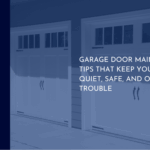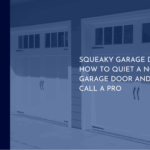Installing a New Garage Door With Matrix Garage Doors
Key Takeaways
- A new garage door enhances curb appeal, adds value, and updates your exterior. Select styles, finishes, and hardware that complement your home’s architecture.
- Insulated doors with higher R-values perform better thermally and save you money. New garage door installation. Weather-strip and foam core cut drafts and regulate temperature in attached garages.
- Contemporary systems add secure reinforced panels, intelligent openers, and rolling code protection. Expert fitting guarantees proper alignment and a good seal for dependable defense.
- Safety is enhanced with auto-reverse, photo-eye sensors, and compliant hardware. Plan for periodic inspections and maintenance to ensure all safety features remain operational.
- More quiet operation from insulated panels, quality weather-seals and belt drive openers. If you’re replacing older systems, it will reduce the noise for living spaces near or above the garage.
- Partner with expert installers for exact sizing, expedited schedule, and warranty coverage. Verify local code requisites, ask for an itemized estimate to anticipate obscure expenses, and maintain documentation for subsequent maintenance.
New garage door installation involves choosing, configuring and installing a new door, track and opener to suit a home’s dimensions, design and security requirements.
Popular options are steel, aluminum, wood and composite, often with insulated panels that aid in heat and noise control. Typical heights are around 2.1 meters with widths from 2.4 to 4.9 meters.
Important considerations include wind rating, R-value, smart controls and warranty. The following details costs, timelines and steps.
Why Install a New Garage Door?

A new garage door transforms how a home looks, works, and feels day to day. It can cut noise, save energy, and add real value, which matters if the garage is your main entry.
1. Curb Appeal
Even if nothing else changes, a fresh door refreshes the entire front of the house. Clean lines, better proportions, and new finishes give façades a facelift and conceal years.
Among the most popular styles are sleek flush panels, classic raised panels, carriage-house with crossbucks, and contemporary aluminum and glass. Finishes vary from matte black to wood-look foils in oak, walnut, or cedar.
Coordinate trim and gutters for harmony. Select a hue that connects to the entryway or window trims. Select handles, straps, and hinges in black, stainless, or bronze to maintain a uniform look.
Insert windows, vertical lites or grille patterns to break up mass and bring daylight inside without sacrificing privacy.
2. Home Value
Garage door replacement scores high for ROI because it raises first impressions and lowers short-term buyer expenses. Sellers recapture almost 95% of the project cost at resale, a figure that’s unheard of among exterior improvements.
People looking for homes want new, quiet, and well-sealed doors. In such close markets, it doesn’t take much to differentiate a listing, and a quality door, clean tracks, and smart entry can do the trick.
3. Energy Savings
Insulated doors help stabilize temperatures in the garage and adjacent or overhead living spaces, reducing heating and cooling consumption. Certain doors have R-values as high as 18 or more, which can come in handy for hot and cold climates.
Steel sandwich doors with a polyurethane foam core trump polystyrene. Fiberglass-faced composites resist rust and can insulate well. Solid wood looks warm but insulates less unless constructed with a foam core.
Seek out full-perimeter weather-stripping, bottom seals, and thermal breaks. Over time, less HVAC runtime translates to consistent savings.
4. Enhanced Security
New systems offer stronger multi-point locking and steel skins with reinforced end stiles. Heavier-gauge tracks and brackets stand up to prying.
Smart openers allow you to see status, set schedules, and share temporary access. Rolling code technology adjusts the code with each cycle to prevent replays.
Professional installation guarantees tight alignment and a true seal.
5. Personal Safety
Old doors can slip, bind, or come crashing down. Photo-eyes and auto reverse stop and lift upon sensing an obstruction. Newer torsion springs and contained systems are safer and quieter.
Set checks and swap out if you notice rot, rust, dents, bent tracks, or weak weather seal.
6. Noise Reduction
Contemporary belt-drive openers operate far more quietly than chain drives. Insulated panels and new weather seals reduce rattling and road noise.
This is helpful when there is living space above the garage or when you bust out early.
7. Lower Maintenance
Vinyl, fiberglass, and composite doors resist rot, rust, and moisture. Select rust-resistant hardware and UV-stable finishes for durability.
Cleaning is easy with mild soap and water. A new door can last you 50 years, reduce surprise repairs, and keep everyday use running smoothly.
When your existing door absorbs moisture, rots, or the frame is bent or rusted, replacement avoids downtime, which is key when the garage is the primary entry and integral to your daily schedule.
Choosing Your Ideal Door

Set priorities first: material for lifespan, style for fit, insulation for comfort and costs, and technology for daily use and safety.
Material
Steel fits most houses. It’s sturdy, low maintenance, and economical, but it can ding and require paint touch-ups. Wood offers a warm, natural aesthetic and can be stained or painted to your trim, but it requires regular maintenance to prevent warp and crack.
Aluminum is light and rust resistant, which comes in handy along the coast, but it dents more readily than steel. Vinyl is great at handling dents and salt, but color selections are restricted. Fiberglass can simulate wood grain with lower maintenance, but it can yellow or crack in strong sun.
- Steel: Pros – strong, affordable, low maintenance. Cons – dents, paint upkeep.
- Wood: Pros – timeless look, customizable finish. Cons – regular sealing, heavier.
- Aluminum: Pros – light, rust resistant. Cons – dents, can feel flimsy.
- Vinyl: Pros – dent resistant, low upkeep. Cons – fewer colors, repairs tricky.
- Fiberglass: Pros include a wood look, light weight, and low upkeep. Cons include UV aging and brittleness in cold.
Select for climate and application. If you live in a wet or coastal area, opt for aluminum, vinyl, or well-coated steel. In blazing sun, lighter shades will fade less. Dark colors may exhibit UV damage. Select a thicker steel or vinyl for busy households to conceal dings.
Material | Typical Cost (EUR) | Insulation Option | Finish Range | Common Warranty |
Steel | 600–1,800 | Polystyrene/Polyurethane | Wide colors | 5–15 years |
Wood | 1,200–3,500 | Add-on panels | Stain/paint | 1–5 years |
Aluminum | 800–2,200 | Limited | Powder coat | 5–10 years |
Vinyl | 900–2,400 | Integrated | Few colors | 10–20 years |
Fiberglass | 1,000–2,800 | Foam core | Wood tones | 5–10 years |
Style
- Contemporary flush
- Carriage-house
- Traditional raised-panel
- Full-view glass
- Minimal frameless-look
We match the door to the home’s lines, roof pitch and façade rhythm. A carriage style can enhance a cottage or farmhouse. Full-view matches contemporary construction.
Introduce windows for daylight and depth, select hardware for detail and add color to tie gutters, trim and door together. About selecting your perfect door, most manufacturers provide wide color selections. Lighter colors fade less in direct sun. Browse catalogs and online galleries for scale and glass patterns.
Insulation
R-value indicates thermal resistance. The higher the R, the better it will hold energy and the higher the cost. For attached garages or rooms above, shoot for higher. For detached storage spaces, a small R may be all you need.
Insulated doors reduce street noise and help motors run smoother as well.
Insulation Type | Benefit |
None (single skin) | Lowest cost, basic use |
Polystyrene (sandwich) | Good value, stiffer door |
Polyurethane (foam-in-place) | Highest R, quiet, strong panels |
Technology
Smart openers with Wi-Fi and app control enable remote checks, alerts, and guest access. Safety basics matter: photo-eyes, auto-reverse, and secure keypad entry.
Tie in to Google Home or Apple Home for routines and voice control. Upgrades range from battery backup and multi-frequency remotes to integrated cameras and motion lights.
Pair opener strength to door dimensions and spring type for effortless, secure lift. Keep bolts tight, parts lubricated, and inspect panels and seals twice a year.
The Professional Installation Process

Professional installation safeguards safety, warranty, and long-term performance. This is where professional installers come in. They follow the manufacturer specifications, have the proper tools, and record every step.
Matrix Garage Doors focuses on accurate measurement, safe handling of high‑tension components, and a transparent handoff so your door operates as engineered. Typical steps include: 1) site prep and measurement; 2) removal of the old door; 3) frame and track setup; 4) panel, roller, and hardware installation; 5) spring and cable work; 6) opener setup; 7) testing and handoff. This order supports precision, warranty, and clean schedules.
Consultation
An in-home visit sets the scope and helps match needs with options. The expert covers door styles, materials such as steel, aluminum, wood, or composite, insulation ratings, window configurations, and security features such as pinch-resistant panels or smart entry.
You get a written quote with door price, labor, disposal, and any add-ons along with an estimated timeline of working days. Our installer goes over the process, safety, warranty terms, and aftercare so expectations are clear.
Measurement
Precisely measuring instead of jam-fitting means it won’t bind and wear out too soon. Pros evaluate opening width and height, as well as headroom, sideroom, and backroom according to the manufacturer, as torsion systems and openers require certain clearances.
They document panel thickness to align hinges, tracks, and opener force profiles. We always measure twice before ordering to prevent accidents, delays, and rework.
Removal
Our technicians will disconnect power, secure the door and release the spring tension with appropriate bars. They will then remove sections and the old opener for environmentally responsible disposal.
Safety equipment, such as gloves, glasses, and work boots, is par for the course. They check jambs, header, and slab for rot, cracks, and out-of-level issues. The opening is cleaned out, old hardware is taken away, and framing is beefed up where required to support new loads.
Installation
Installers begin with the frame and mounting pads. They then set vertical and horizontal tracks with a level, a drill, a socket set, and fasteners appropriate to the substrate.
This method supports a genuine opening so panels slide without rub. They stack panels from the bottom up and fit hinges, rollers, and cable brackets as per instructions. Weather-stripping is applied to the bottom panel to seal against drafts and moisture.
Springs and cables, which are under high tension, are only touched by our trained techs. Then, your opener is mounted, rail aligned, and lifting hardware connected. Ladders or scaffolds assist in accessing higher mounts.
Final Checks
They test smooth travel, balance and auto-reverse with photo-eyes and force settings. Hardware and fasteners are retorqued, cables checked for fray, and seals confirmed to have an even contact line.
They walk you through manual release, periodic inspection, light lubrication points and service intervals. Matrix Garage Doors records model numbers and compliance to protect your warranty and peace of mind for years to come.
Professional vs. DIY Installation

Choosing between a professional install and a DIY approach comes down to safety, time, tools, and long-term reliability. Professionals come with trained crews, specialized equipment, and a procedure that leaves the door aligned, balanced, and tested.
On the other hand, DIY provides control over pace and timing and can reduce labor costs, but frequently extends schedules and increases risk. Complex or heavy doors, such as insulated steel, full-glass, or wider than 4.9 meters, require professional installation to guarantee stable tracking, correct spring tension, and easy open and close cycles.
The Safety Argument
Garage door torsion springs contain a significant amount of energy. Untrained handling of them can cause serious injury. Even minor mistakes, such as improper winding turns, mis-set cable drums, or loose anchor brackets, can break parts under load.
These issues can damage the door or opener. Bent tracks, misaligned photo eyes, and out-of-square framing put a strain on hardware and motors. That strain frequently manifests itself down the road as sudden failure or the door sagging.
Professionals follow strict steps: locking out power, securing the door in the up or down position, setting spring torque by door weight, checking track plumb and level, and testing safety reversal at 20 to 30 mm contact.
They install with calibrated winding bars, laser levels, heavy-duty anchors, and torque wrenches. For those who value safety, employing tested professionals minimizes hazard and guarantees the door is installed correctly the first time.
The Time Factor
With professional teams typically completing the installation in one day, from tear out to new hardware, opener integration, and haul-away, there is less hassle and less downtime. This leads to sooner enjoyment of a safe, silent door.
In contrast, DIY projects tend to run long. Learning every step, tracking down parts you don’t have, and undoing mistakes can stretch a weekend into multiple. If you don’t have project experience similar to this, expect to take additional time and be patient.
Installers deal with surprises such as twisted jambs, out-of-level slabs, and weird header heights on the fly with shims, low-headroom kits, or high-lift conversions. Downtime stays low and your schedule stays intact.
Scheduling is simple. Book a slot that fits your week, not the other way around.
The Warranty Question
So many manufacturers insist that you have it installed professionally in order for the warranty to cover it. Save receipts and installer information, as claims can depend on them.
DIY blunders, such as improper spring size or missed reinforcing strut, can nullify product warranties and drive up subsequent repair expenses. Labor warranties from trusted companies provide an additional safety net that covers tune-ups and call-backs within a specified timeframe.
Make sure to verify terms before you begin. Check which parts are covered, the duration, and if labor is included.
Beyond the Basics
New garage doors impact safety, energy efficiency, noise, and curb appeal. Consider rules, extra costs, and care that keep the system humming for years.
Local Codes
Let’s start with the basics. Several cities do ask for a permit on a new or replacement garage door. Know your city or county ordinances first, and get the permit before you begin work. Certain parts of the country have wind-load ratings. Coastal or high-wind areas may need reinforced panels and heavier tracks.
In wildfire zones, codes may require certain clearances or materials next to common walls. Insulation standards can factor in as well, with insulated steel or aluminum doors approaching R-17 and most wood doors maxing out near R-10. This counts in cold or searingly hot climates.
If you live in a managed community, check your HOA rules on colors, panel patterns, window styles, and finishes. Mismatched styles can incur fines or forced changes, which can be expensive once installed.
Professional installers know local codes and have equipment to adjust photo-eye detectors and tension springs. A typical double door weighs 70 to 90 kg, and 0.56 kW (3/4 hp) rated openers can lift doors up to approximately 450 kg and 6 m wide. DIY is feasible but slow; first-time installs can take a day or weekend.
Hidden Costs
Plan for haul-away fees for the old door and hardware. If the opening is out of square, anticipate carpentry to reframe or brace. Electrical upgrades could be required for a ceiling outlet, new wiring to the opener, or outlets for battery backups.
Leave space for advanced rollers, torsion springs with a greater cycle rating or a whisper quiet, belt-drive opener with Wi-Fi. Custom windows, colors, or odd sizes increase price and lead time.
Ask for a written, line-item quote: door, tracks, springs, opener, hardware, permits, delivery, tax, and labor. Add potential bonuses such as emergency service if the door breaks mid-project. With a transparent quote, we keep surprises off your invoice.
Future Care
Schedule service checks annually, but heavy use homes may require checks every six months. A quick home checklist every six months helps: lubricate hinges, rollers, and springs, inspect cables for fray, test photo-eye sensors for instant reversal, and replace dim opener bulbs.
Hang onto warranty papers and receipts in one folder. Record install date, model numbers, and service visits. This accelerates claims and parts ordering.
Keep an eye out for noisy travels, jerky motions, slow starts or a sagging door line. Swap out old weatherstripping pre-winter. Seals are simple DIY and inexpensive. Springs aren’t DIY. Employ pros, and if you’ve got to work nearby, clamp tracks and avoid the spring path.
Conclusion

A new garage door has obvious returns. It operates with less noise. It has an improved seal. It reduces heat loss. It provides safer equipment with smart locks and photo eyes. It enhances curb appeal that raises home value. A steel door with foam fill provides durable insulation. A glass-and-aluminum door adds light for a shop space. Real wood suits a cozy, traditional style.
To keep the swap smooth, figure out the size, track type, spring type, and opener torque. Schedule a specialist for spring tension and security balance. Keep the door in shape with an annual tune, new rollers, and a clean track. Little things add up to big savings.
Need assistance to select a style or fit quote. Just email a picture of the opening and rough dimensions. Let’s pick out the perfect door for your opening!
Frequently Asked Questions

How do I know it’s time to replace my garage door?
Be on the lookout for frequent breakdowns, noisy operation, sagging panels, poor insulation or outdated safety features. If your repairs are expensive or parts are no longer available, a new door is the safer, higher performing, more attractive solution.
What garage door material is best for my climate?
Steel fits most climates and requires minimal upkeep. Aluminum resists rust in coastal areas. Wood provides a traditional appearance but requires maintenance. Composite replicates wood with less maintenance. Insulated doors are excellent in hot and cold regions.
How long does professional installation take?
A typical new garage door installation takes about 3 to 6 hours. Custom sizes, opener upgrades, structural fixes, or electrical work will add to that time. A site check helps validate the schedule.
Is DIY installation a good idea?
That is, unless you’ve got the proper tools and training. Torsion springs and track alignment are dangerous. Errors can void warranties and compromise safety. In the vast majority of cases, professional installation is safer and more reliable.
What insulation (R-value) should I choose?
Target R-9 to R-13 for mild climates. Go higher for extreme heat or cold, attached garages, or if the garage is a workspace. Better insulation means more comfort and extends energy efficiency.
Do I need a new opener with a new door?
Not necessarily. If your opener is 10 years or older, noisy, or without safety sensors and smart features, upgrade it. A new opener can sync with the door’s weight, enhance security, and provide convenience.
How much does a new garage door cost?
Prices depend on size, material, insulation and hardware. Count on a standard single door to run from the mid to high hundreds to a few thousand dollars installed. A pro quote guarantees correct price and warranty information.



